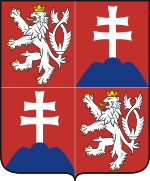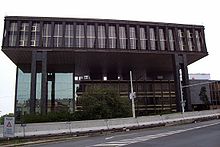Federal Assembly (Czechoslovakia)
|
Federal Assembly of the Czech and Slovak Federative Republic Federální shromáždění ČSFR (Czech) Federálne zhromaždenie ČSFR (Slovak) |
|
|---|---|
| Legislative body in Czechoslovakia | |
 |
|
| Type | |
| Type | |
| Chambers |
House of Nations House of the People |
| History | |
| Established | 1969 |
| Disbanded | 1992 |
| Preceded by | National Assembly |
| Succeeded by | |
| Seats |
350 members (1969–1990)
300 members (1990–1992)
|
| Elections | |
| Direct non-competitive elections (1969–1990) Direct competitive proportional representation (1990–1992) |
|
|
Last election
|
5–6 June 1992 |
| Meeting place | |
 |
|
| Federal Assembly, Prague | |
350 members (1969–1990)
300 members (1990–1992)
The Federal Assembly (Czech: Federální shromáždění, Slovak: Federálne zhromaždenie) was the federal parliament of Czechoslovakia from January 1, 1969 to the dissolution of Czechoslovakia on December 31, 1992. It was Czechoslovakia's highest legislative institution.
Chapter 3 of the 1960 Constitution of Czechoslovakia recognized it as "the supreme organ of state power and the sole statewide legislative body."
The Federal Assembly was divided into two equal chambers, the Chamber of the People (Sněmovna lidu; other translation House of the People) and the Chamber of the Nations (Sněmovna národů; other translation House of Nations). The Chamber of the People reflected a system of proportional representation: in 1986 it included 134 deputies from the Czech Socialist Republic and 66 deputies from the Slovak Socialist Republic. The Chamber of Nations had 150 members, 75 from each republic. Deputies were selected through popular elections and served five year terms of office; all 350 served concurrently.
After an election each chamber met to select its own Praesidium consisting of three to six members. Together, the chambers elected the forty-member Presidium of the Federal Assembly, which served as the legislative authority when the assembly was not in session. A joint session of the Federal Assembly selected its chairman and vice chairman. Alois Indra served as chairman from 1971 to 1989.
The Federal Assembly met in regular session at least twice a year, in the spring and fall. Legislation presented to the assembly at these sessions had to be approved by both chambers and in some cases required a majority vote by both the Czech and the Slovak deputies in the Chamber of the Nations.
Constitutionally, the Federal Assembly was vested with great lawmaking powers. In theory, it had exclusive jurisdiction in all matters of foreign policy, fundamental matters of domestic policy, the economic plan, and supervision of the executive branch of government. In practice, however, as in other Communist states, its function was largely confined to rubber-stamping measures placed before it by the Communist Party of Czechoslovakia (KSČ). Laws in Czechoslovakia were drafted in advance by the Presidium of the KSČ and presented to the Federal Assembly, which almost always approved them unanimously.
...
Wikipedia
